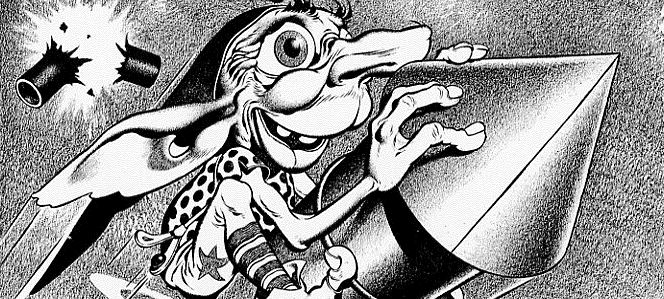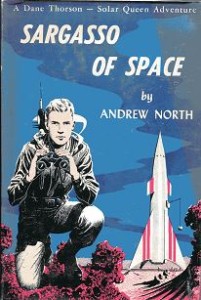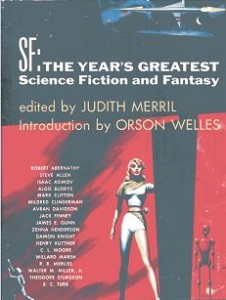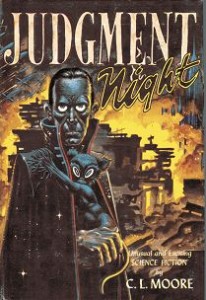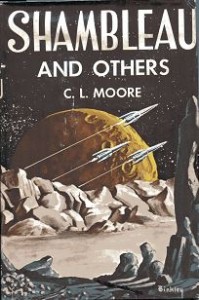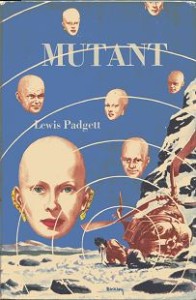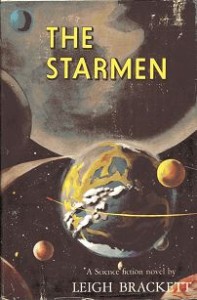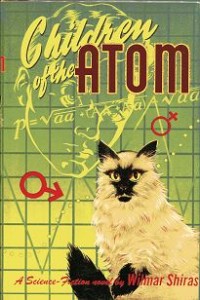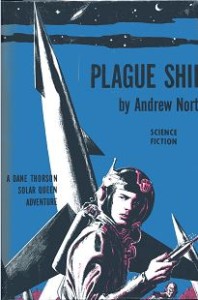This article was originally published in the New York Review of Science Fiction #326, November 2015
Science Fiction became literature in the half decade after World War II. Not because of any intrinsic rise in the quality of the works, not even because rockets and atomic energy had moved from the pages of fiction to the front pages of newspapers. Science fiction became literature purely and simply because it began being offered in hardcovers rather than confined to pulp magazines.
The availability of a book in hardback meant everything to 1940s cultural standards. Bookstores could carry them and give them the imprimatur of class. Libraries could place them on shelves next to the most respected authors. Newspapers could review them, and that very presence implied they must be taken seriously and judged by the same standards as other fiction. The New York Times started a semi-regular column called Realm of the Spacemen in 1950, an acknowledgement of the field that it conspicuously lacks today. Though the era of Wells and Verne was long past, and from a time before the very term science fiction had been coined, they were name-checked constantly and the resurrection of their prescient treatment of onrushing technology conveyed an aura of respectability over a once-scorned outpost of fiction.
The mainstream publishing industry knew nothing and cared less about science fiction (a term then starting to encompass fantasy for marketing purposes, which I’ll shorten to the more modern f&sf). It had to be proven to them that such books could sell. A multitude of f&sf fans saw an opportunity and started an equal multitude of small presses. One stands out.
Gnome Press lasted longer, produced more titles, and sold more copies than any of the other small presses. It published 32 books by SFWA Grand Masters: the first eight – Robert A. Heinlein, Jack Williamson, Clifford D. Simak, L. Sprague de Camp, Fritz Leiber, Andre Norton, Arthur C. Clarke, and Isaac Asimov, plus an additional six – Frederik Pohl, A. E. van Vogt, Poul Anderson, Hal Clement, Robert Silverberg, and James Gunn. (One other, Harry Harrison, drew a cover for a book jacket, proving mostly that his future lay as a writer.) These names define what we think of today as classic f&sf – the Golden Age.
Martin Greenberg and David A. Kyle together founded Gnome in 1948 but Kyle concentrated on the production end and left in the early 1950s; Greenberg always handled authors and decided what got printed. As with every editor he had his personal tastes and predilections; he plundered the pages of John W. Campbell’s Astoundings and Unknowns, which dominated and defined the decade, for dozens of stories and novels yet made sure to find material in lesser publications, inside the field and out, especially in the 1950s. More, he understood both the power of a well-respected name and the need to build for the future with those just starting: several of those Grand Masters were published in the dawns of their careers. Gnome was therefore a reasonable microcosm of the field, not merely a greatest hits retrospective.
Today we can’t read that list of names without noticing that all, with one exception, are male. Eighteen of the first 19 Grand Masters were, in fact. Most people would consider that representative of the Golden Age as well. Gnome confounds that. Of 72 fiction titles in its 14-year lifespan, nine were written or co-written by four woman: C. L. Moore (under her own name and in collaboration with Henry Kuttner under the pseudonym of Lewis Padgett), Leigh Brackett, Wilmar H. Shiras, and Andrew North (a pseudonym of Andre Norton). That far higher percentage carries its own kick: none of the four (or six) names are immediately recognizable as female, and two are indisputably (and intended to be) male. Is Gnome to be commended for disproportionately publishing women or condemned because it hid woman from an audience that seemingly catered only to males? Or is our entire current appraisal of the Golden Age skewed by nostalgia, biases, and faulty memory?
When the story of f&sf is recounted, as told by numerous women themselves, it is of a field so overwhelmingly male that women were, deliberately or by implication, shut out from it. Editors did not want to buy stories from women; if they did, they altered or invented names to hid their femininity, doing so on the presumption – or actual sales experience or feedback from readers – that female names did not sell and might even actually repel buyers. The group memory says that women were secondary, underappreciated, discouraged, or hidden and therefore lacked the easy pathways into the field that men took for granted. The evidence for this is often from statements like those by Alice Sheldon, who admitted that she deliberately hid her real identity under the pseudonym of James Tiptree, Jr. , a ruse that was successful for nearly a decade, because she’d “had too many experiences in my life of being the first woman in some damned occupation.”
We have the tools today to provide a numeric context for those feelings thanks to Partners in Wonder: Women and the Birth of Science Fiction, 1926-1965. Written by Eric Leif Davin and published in 2006, it is a masterpiece of scholarly fieldwork. He went through, page by page, literally every professional science fiction magazine published in America during those 40 years, recorded the name of every listed author of fiction, did as much digging as possible to determine their true name and sex, and checked every title page, introduction, letters section, and coming soon page to see if the female authors were referred to by their gender by either editors or readers and if those references were positive.
His findings, spread throughout a dense 315 pages and summarized in a long series of tables, belie any claims that women were excluded from the f&sf magazines. (Pure fantasy magazines, like Weird Tales, are relegated to a subsidiary set of tables. Unknown, John W. Campbell’s fantasy companion to Astounding, is, however, counted.) In fact, he found 203 female authors of 988 stories, and that does not include a few dozen names that simply cannot be traced to individuals. He separates his tables into the years 1926-1949, 1950-1960, and 1961-1965. In 1926-1949, a fortuitous grouping I’m calling the pre-Gnome era, the period from which the vast majority of Gnome authors emerged, the numbers are smaller though still far from zero: 68 authors of 288 stories, including 5 stories given female pseudonyms by male writers. Unfortunately, Davin does not provide the total number of stories published, but from other sources a quick estimate is that 50 magazines appeared in an a typical year with an average of eight stories per issue. That’s 400 stories a year of which women contributed about 12, or 3%.
Gnome’s numbers look pretty good against this background, and even better if you dive deeper into the data set. Those four women were about 10% of the 46 authors whose fiction Gnome published in book form. Of individual titles, 64 were by men, 7 by women, and two by the man/woman team Henry Kuttner and C. L. Moore, writing as Lewis Padgett. This base of ±10% by women holds true if one checks the stories in Greenberg’s six anthologies (out of 63 stories, 3 were by women (E. Mayne Hull as E. M. Hull, C. L. Moore, and Judith Merril), and 2 by Lewis Padgett) or in Judith Merril’s four (1 by a team, again Kuttner and Moore under their real names, and 6 by women: 3 by Zenna Henderson and 1 each by Shirley Jackson, Mildred Clingerman, and Carol Emshwiller). This is a far higher percentage than any of its small press contemporaries, none of which published more than a single book by a woman.
The problem with Davin’s book is that it is a screed in a good cause, that of showing women did write f&sf. To do so it is required to take statements like Sheldon’s literally rather than metaphorically. No one else to my knowledge asserted that women were truly completely excluded from f&sf, either among writers, readers, or editors. Davin presents the necessary numbers; readers must supply the necessary context. When he cites a long list of men and women claiming that women writers were excluded from f&sf, we should read that as a memory of a time when women were more than merely a low percentage of total authors; they were an almost certainly lower percentage of important and memorable writers. They existed, they were praised, but only a handful cast the long shadows that made them come instantly to mind decades later as exemplars of the field. Out of all the 68 entries in Davin’s pre-Gnome era list of women, Moore’s is the single name which can be considered for inclusion among that handful, a true star of the field.
A standard taxonomy is almost universally deployed, by fans, by editors, and by other writers. On top are the stars, the major figures who define the field, whose names sell magazines, whose stories both adulating fans and envious competitors look forward to. On the next level are the journeymen (even the name is historically indicative), with solid work, known readability, and some immediate name recognition. And then there are everybody else: the one-shots, the short-timers, the fast-faders, the wannabes, the slumming mainstreamers, the occasionals, the oddities, the accidents. As I hope should be obvious, “everybody else” is not a euphemism for dismal. Their stories ranged from brilliant to awful; they are lumped solely by lack of prolificness.
Davin’s appendices reveal that of the 67 women not named Moore in his 1926-1949 listing, only a literal handful, five, published more than ten stories, a very low bar considering that Moore has 55 credits. (Serializations count as one credit, but would have brought the name into more tables of contents.) Leigh Brackett, a top journeyman, is a distant second at 34. The others are the team of Dorothy and John De Courcy, Margaret St. Clair, Leslie F. Stone, and E. Mayne Hull. Only St. Clair had a name that was an immediate identifier of a solo woman. Whether Hull should be counted is now a matter of contention. Some have argued, from Campbell’s letters, that he placed the name on A. E. van Vogt’s overflow work. A brief mention should be made of Amelia Reynolds Long, who just misses with exactly ten stories. When F. Orlin Tremaine edited Astounding he ran three stories by A. R. Long before expanding her name to the full, identifiably female, appellation. Few other than dedicated fans would be able to recognize these other names in 1950.
This dominance in terms of number and reputation pops out of the Gnome data; women would be a much lower set of percentages if it were not for C. L. Moore. She accounts for five of the nine books by women, three of the five stories in Greenberg’s anthologies, and one more in Merril’s. Moore wasn’t merely good; she was instantly recognized as special. When Farnsworth Wright, the editor of Weird Tales, saw her first submitted story in 1933, he declared it C. L. Moore Day, an excuse to stop reading slush and risk spoiling the moment. Sam Moskowitz, who tells this tale in Seekers of Tomorrow, also says that he handed the story to E. Hoffman Price, then a superstar of the pulps, asking him “Who is C. L. Moore? He, she, or it is colossal!” That story, “Shambleau,” would become a Gnome title and appear in an anthology on average twice a decade for the past 80 years. F&sf is not different from any other field of entertainment. It is star-driven. Publishers were more likely to put out titles by stars, anthologists were more likely to include stories by stars, and Grand Master Awards are more likely to be a listing of stars. Stars dominate contemporary perceptions and perhaps disproportionately dominate memory.
And the audience wants to know more about stars. In the 1930s-1940s world of multiple pseudonyms, few fan get-togethers, and a near total lack of book jacket information, could readers know who the person behind a story was and did they care whether it was a man or a women? Davin insists his research proves that readers knew and didn’t care.
[Moore’s] gender became publicly known to fandom only a few months after her debut, “Shambleau,” appeared [in the November 1933 Weird Tales]. Julius Schwartz and Mort Weisinger revealed it in the May 1934 issue of their fan magazine, The Fantasy Fan. Weird Tales itself explicitly referred to her as female in its September 1935 issue. And when Moore herself published a letter in its reader column, she made no attempt at concealment, signing herself, “Miss Catherine Moore.”
Reader reaction to Moore’s debut in Astounding [in November 1934] was warmly receptive. Among those writing letters to praise her first story were Robert A. Lowndes … and E. E. Smith, both explicitly referring to Moore as a woman. … Similar letters praising Moore and referring to her as a woman can be found in the Astounding issues of February, April, and December 1935; February, 1936; and February 1937.
Insiders clearly could know, but not every fan read every letter column in every magazine – even those fans who sent letters to magazines. On the archive site efanzines.com I found a 2004 reminiscence by A. Langley Searles, whose name pops up in the letter columns of Startling Stories and Unknown in 1939, admitting that “For a very long time I thought Leigh Brackett and C.L. Moore were men, and then I met them… In those days it was commonplace to make those mistakes.” [SaFari, Vol. 3 No. 2, FAPA 266, February 2004] Davin quotes Marion Zimmer Bradley as saying that Moore used initials to disguise her work not from chauvinist editors but from her bosses at the bank where she worked as a teller. Fiction writing and most especially weird fiction writing could certainly led to unemployment by association during the Depression. A pseudonym might have been safer but the mere use of initials connoted a man.
What of those who might be fans without being insiders? The best evidence we have that not everyone knew comes from Henry Kuttner himself. Kuttner was a budding writer: his first published story appeared in the March 1936 Weird Tales. Nevertheless, he was such an outsider that when he wrote a fan letter to Moore he had to send it to the Weird Tales offices to be forwarded; moreover he addressed it to “Mr. C. L. Moore.” The date of the letter is unknown for certain, though one source gives it as 1938. If so, things moved fast from there: they were married in 1940, their Lewis Padgett joint pseudonym started appearing in 1941, and an alternate joint pseudonym Lawrence O’Donnell followed in 1943, with the result that almost all Moore’s work after the early 1940s was under other names. According to Moskowitz, this wasn’t to hide Moore’s name but Kuttner’s. His early writing had such a “tarnished reputation” that a new name was thought to be essential.
Once is happenstance, twice is coincidence, four times is conspiracy, to paraphrase Ian Fleming. Did Gnome’s readership know that they were reading works by women? Publishing f&sf in hardcovers had created an entirely new audience for the genre over and above the magazine fan community, many of whom would encounter f&sf for the first time through libraries and booksellers rather than newsstands or drug stores. Although the conventional wisdom would have it that Gnome concealed this information, it actually trumpeted the news.
No observant reader could miss the fact that Gnome’s first book by Moore, Judgment Night, had been written by a woman; the front cover flap forthrightly refers to the author as “her” twice. So does the advertising copy in the Gnome 1953 catalog. Moore’s gender is even more pointedly stated on the flaps of her next Gnome collection, Shambleau and Others. There she is called Miss Moore twice as well as “the wife and collaborator of Henry Kuttner.” Her last collection, Northwest of Earth, again has her as Miss Moore on the flaps. Yet as soon as we reach out to praise Gnome, a confounding fact rears: Greenberg seemingly took care to hide her identity as half of the Lewis Padgett team. Virtually all publishers did in the 40s and 50s, for unexplained reasons. Insiders knew. At efanzines.com, the April-May 1947 issue of Fantasy Review references matter-of-factly “Henry Kuttner and wife C. L. Moore, writing as Lewis Padgett and Lawrence O’Donnell.” The three Padgett titles Gnome published made it clear that Padgett was Kuttner; each had an “other books by” page that listed “Fury by Henry Kuttner” but never mentioned Moore’s name at all. The O’Donnell teaming was also passed over. Judgment Night collected four Lawrence O’Donnell stories without ever mentioning they had first appeared under that name. Some readers must have been surprised by seeing them under Moore’s authorship. True, confusion over which stories were joint and which were not reigns until today. Many of the Padgett stories were Kuttner’s alone, including all the Gallagher stories collected in Gnome’s Robots Have No Tails. Those O’Donnell stories in Judgment Night are thought to be Moore’s alone, unless that’s circular reasoning from their inclusion. Even so, ascribing all the other Padgett and O’Donnell stories to Kuttner became a common convention in anthology tables of contents, and probably caused the drastic dip in Moore’s status that followed. At the time, though, Moore’s name sold. Why the always desperate-for-money Greenberg would suppress a good fraction of her potential sales is one of many mysteries about Gnome’s operating procedures.
Similarly, Leigh Brackett is referred to as “Miss Brackett” on the front cover flap of The Starmen and Wilmar H. Shiras is “Mrs. Shiras” in the About the Author section on Children of the Atom’s rear flap. Both used their birth first names; there is no evidence that either sought to confuse anyone. Brackett was part of the Los Angeles fan and writing scene from 1939; she left only when she married fellow writer Edward Hamilton in 1946. They shared similar tastes in f&sf, with both writing swift-paced planetary romances of a sort that didn’t appeal to John W. Campbell and went out of style in the 1950s. Her one Gnome novel, The Starmen, received mixed reviews, reviewers finding the space opera routine at best. She was known for writing hard “masculine” prose. Gardner Dozois, in The Good Old Stuff, cites the “legend” that her first novel, a hard-boiled mystery called No Good From a Corpse, drew a call from Hollywood after director Howard Hawks told his assistant to “get me that guy Brackett.” No quote from Hollywood can ever be assumed to be true and not the invention of some clever writer, but the source of the legend can be pinned down as John Leonard Carr does in his dissertation, Leigh Brackett: American Science Fiction Writer – Her Life and Work:
Hawk’s surprise – and one wonders, his discomfort – at discovering Brackett to be a woman was widely reported at the time, and became an item in a Hollywood gossip column. Hedda Hopper, Hollywood’s professional gossip, informed readers that Hawks told his agent, “This fellow would make a good screenwriter for The Big Sleep; get Mr. Brackett for me.” In spite of his astonishment at being confronted by a fresh-faced young woman, not yet thirty, he stuck by his decision. Brackett, naturally, told the story of her original interview with Hawks many times; it was as stapel [sic] of her interviews. [p. 60]
Brackett was not quite the flower naively waiting to be plucked as this makes her out to be. Carr also notes that she had had a credit on a Republic quickie in 1944 and that Hawks contacted her through her agent, indicating she was actively pursuing more screen work. The anecdote does serve to emphasize her ambiguous name and the vast gulf between the insider fans and the outside world even within Los Angeles.
Wilmar H. Shiras – the H stands for House, her maiden name – was as quintessentially an outsider oddity as Brackett was an insider’s insider. She published a mere three stories in Astounding to which she would add two more when Gnome published Children, comprising almost the totality of her career in the field. Her identity as a woman was apparently not known even inside fan ranks. The fanzine Fantasy Review, so quick to reveal insider pseudonyms, didn’t have a clue. In the April-May 1949 issue, reviewer Kenneth Slater looks at the issue of Astounding with “Opening Doors,” the sequel to “In Hiding,” and calls the author “he.” Conversely, the Reno Evening Gazette on October 29, 1953, reported that a book group had reviewed a book by “Wilma H. Shiras.” Her hometown newspaper in Oakland ran a feature story on her next to their review of Children, revealing that she had married at 18, and now struggled at home with “two boys, three girls, five cats (four Siamese, one ‘plain’), two dogs, and two large aviaries in the back yard.” Shiras, who was 45 at the time, also had returned to college to complete the degree she had abandoned for marriage, and was doing translation for a New York publisher “on the side.” When asked “How do you cope with all this?” she responded “By not doing housework.” Tropes are tropes for a reason. The reporter noted that the original story, “In Hiding,” a work of soft science fiction about mutated supergenius children, had caused a “furore [sic] in the science fiction circles,” presumably because it was so, well, womanly.
If Moore, Brackett, and Shiras are forthrightly announced as women, what are we to make of the two Gnome young adult (YA) books subtitled “A Dane Thorson – Solar Queen Adventure”? Both Plague Ship and Sargasso of Space are credited to Andrew North. Neither have an About the Author section. Indeed, not a single word is said about the author. Greenberg absolutely knew the author’s identity: Andre Norton was his editorial assistant at the time. For the first time, a marketing strategy may have been involved and justified. Whatever the attitude about female writers or protagonists in the world of f&sf might been, the YA world was fixed and locked. Everybody in it, from editors and publishers to the librarians who were the most important buyers of the books, believed beyond any doubt that boys read books by men about boys. The other five YA books Gnome published – Mel Oliver and Space Rover on Mars, by William Morrison; Starman’s Quest by Robert Silverberg; and the series Undersea Quest, Undersea City, and Undersea Fleet, by Frederick Pohl and Jack Williamson – had male protagonists as well. It is only very recently that publishers have dared buck this trend to any degree. It is as certain as anything about Gnome can be that these YA books were deliberately hidden behind a male name.
Why Andrew North, though? She could logically have used Andre Norton, a name that already sounded male, that was the author’s legal name, that was picked precisely because it appeared to be male, and that she adopted because she “expected to be writing for young boys, and the male name was expected to increase her marketability,” according to her biography on her tribute website, andre-norton.org. The answer is prosaic. She had already done three novels and three anthologies for World Publishing Company. It’s always been common for prolific authors to adopt pseudonyms when they worked for competitors and that appears to be the simple answer here.
Only a small nagging fact remains. Norton’s first three science fiction short stories were published under the name of Andrew North before she became affiliated with World. The first two, “The People of the Crater” and “The Gifts of Asti” were in Fantasy Book’s first issue (late 1946 or 1947) and third issue (1948), and “All Cats are Gray” appeared in Fantastic Universe, August-September 1953. Although Fantasy Book has terrific cachet today as the first magazine to publish a Cordwainer Smith f&sf story, it was mostly a fanzine created to publish Crawford’s friends in Los Angeles, then figuratively even more distant from the New York center of publishing than it was literally. Crawford knew the midwesterner Norton from back in the 1930s when she submitted a story to his Marvel Tales, which died before he could publish it. Norton perhaps wanted a separate name for her genre stories or perhaps didn’t think this piece up to her standards. Whatever the case, the North name lived on to be placed on a third Solar Queen volume, 1959’s Voodoo Planet. When the fourth book, Postmarked the Stars, appeared in 1969, her real name was too valuable to leave off and later printings of all the titles have prominently featured the Norton name.
Gnome finally died in 1962, when the prospects for f&sf as a genre were so gloomy that writers were fleeing the field. None of the prophets of the future saw the paperback revolution about to take off, or the New Wave changing the preferred subject from outer to inner space, or female editors like Cele Goldsmith welcoming a new crop of woman writers into Amazing and Fantastic. Gnome died because Greenberg was a poor businessman, but semi-amateur insider presses couldn’t hope to battle with mainstream publishers who almost universally created f&sf lines and printed up paperbacks by the millions. Golden Age writers felt extremely dated by the 1970s; to many it seemed like f&sf had rebooted and history started with SFWA and the Nebulas in 1965.
Two complementary truths emerge from the Golden Age. The field was predominantly male; writers, editors, readers, publishers, fans, artists, every possible grouping contained probably 90% men. Yet that remaining 10% was significant. Women were not singled out and marginalized by their gender, not unwelcomed, not rejected out of hand. They faced the obstacle of being a small minority and the low level of support and encouragement that resulted, but they received credit and approbation proportional to their numbers. The larger society, the one that so many insiders felt alienated from, had more to do with the infrequency of a female name in a table of contents than blackballing by the club. The meaning of those names, their fame, their influence, their respect, their legacy was at potent in their time as it is today. An equivocal victory for the field, perhaps, but not a shameful one.
